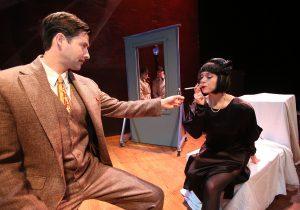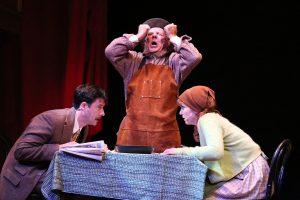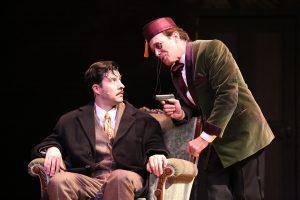Review Fun Fact: “Mr. Memory” was based on an actual vaudeville-like act.
You don’t have to be the British music hall savant “Mr. Memory” - or a man who knew too much - to remember that Alfred Hitchcock was nicknamed “the Master of Suspense.” But if Hitch had directed the Patrick Barlow stage adaptation of The 39 Steps - which toured England and scored the Olivier Award for Best New Comedy in 2007 then ran on Broadway for two years - instead of his spy movie of the same name, the famed British movie director might have been called “the Master of Silliness.”
Or “the Maestro of Merriment,” because Barlow’s two-act takeoff on the 1935 espionage thriller starring UK actors Robert Donat and Madeleine Carroll is simply hilarious. The witty comedy’s conceit is that every single character from Hitchcock’s screen version is re-enacted by a cast consisting of only four thespians (give or take a mannequin or two). With the doffing or donning of a cap, the way a jacket is partially worn, the switch of an accent and so on, the incredibly skilled ensemble morph themselves from one incarnation to another at warp speed. (Kudos to costume designer Kim DeShazo and scenic designer Fred Kinney, whose sets are part of the play’s all-purpose good fun.)
Ashley Morton assays the main female parts, Pamela - who becomes manacled to the leading man - and the counterespionage agent Miss Smith. (Hitchcock cannily cast the Berlin-born actress Lucie Mannheim to depict the spy as a way to get around pre-WWII censors to warn moviegoers about Germany’s looming threat.)
As Man #1 and Man #2, Bo Foxworth and Louis A. Lotorto contort themselves into role after role - occasionally in gender bender parts, too. Whether playing Scottish innkeepers, a farmer and his wife, the spies’ ringleader who is missing part of his pinky or Mr. Memory (the know-it-all character Hitchcock concocted, as he confessed to fellow filmmaker Francois Truffaut, “based on a true-life music hall personality called Datas” and added to the movie based on John Buchan’s 1915 novel), Foxworth and Lotorto are whirling dervishes at fever pitch in this cleverly inventive theatrical whirligig. (Foxworth’s comic turn is all the more astonishing as this versatile thesp starred in L.A.’s Fountain Theatre Building the Wall, Pulitzer Prize-winner Robert Schenkkan’s profound prescient 2017 drama about President Trump’s immigration crackdowns.)
In fact, the sole member of the frenetic cast who seems to depict only one character is Eric Wentz as the lead, Canadian Richard Hannay, who stumbles into a world of intrigue when he buys a ticket to a London variety theater. Along with the opening night audience at Long Beach’s International City Theatre, Wentz had fun lampooning the Hannay of Manchester-born Robert Donat, who personified the Brit persona for Yankee moviegoers in 1930s classics such as The Count of Monte Cristo and Goodbye, Mr. Chips.
Above all, Barlow’s The 39 Steps is a delight for movie buffs, especially Hitchcock fans. Like Mel Brooks’ 1977 High Anxiety, this genre spoof pokes fun at various Hitchcockian conventions. Wentz’s Hannay is the archetypal innocent man wrongly suspected of foul play - this is such a recurring theme in Hitch’s oeuvre that Henry Fonda even starred in his 1957 movie called The Wrong Man. 39’s police - or rather, constables - are inept and useless, just like the lawmen in Psycho and so many other Hitchcock films. Morton joins her onscreen predecessor,
Madeleine Carroll, as a beautiful blonde “iceberg maiden” who typified the Hitchcockian leading lady actresses such as Grace Kelly, Eva Marie Saint, Kim Novak, Janet Leigh and Tippi Hedren also played. And the production’s title - The 39 Steps - is a perfect example of what Hitch called the “MacGuffin,” “the device, the gimmick” to advance the plot. (But if you want to find out exactly what the 39 Steps are you’ll just have to see the show, DearReader!)
Onstage, there are references galore to various other Hitchcock pictures sure to delight vintage film fans. Snatches of composer Bernard Herrmann’s scores from movies such as North by Northwest are heard. (Sound designer Dave Mickey’s recorded soundtrack enhances the revelry throughout.) Psycho’s shower stabbing scene is depicted via shadow puppets on what appears to be a shower curtain. The action onstage unfolds at a fast pace like in those rapidly edited montage sequences in Saboteur, Psycho, etc. The play’s pithy patter refers to pictures like The Lady Vanishes, Vertigo, Rear Window and The Man Who Knew Too Much.
Cinefiles are more likely to know about the 1956 color version of the film starring Doris Day and Jimmy Stewart, but this is a remake of Hitchcock’s 1934 The Man Who Knew Too Much, the movie co-starring Peter Lorre that he shot just before making The 39 Steps. The black and white original iteration opens at St. Moritz, that posh Engadine Valley village surrounded by the Swiss Alps, and includes scenes of outdoor sports and a luxury resort that appears to be Badrutt’s Palace. Switzerland left an indelible impression on Hitchcock’s mind and the movie he shot immediately after 39 is likewise set in part at the Alpine nation. 1936’s Secret Agent, co-starring Madeleine Carroll, Peter Lorre, John Gielgud and Robert Young, also has Swiss scenes and is another one of Hitch’s forays into the realm of international intrigue, derived from a Somerset Maugham novel.
Why did Switzerland have such as huge impact on one of the cinema’s greatest directors? According to the blog https://the.hitchcock.zone/welcome/: “Alfred Hitchcock first visited St. Moritz during the filming of The Prude's Fall (1924) and returned there with Alma Reville on their honeymoon in December 1926, where they stayed at the [Badrutt’s] Palace Hotel. From then onwards, they often returned to spend their Christmas vacation at the hotel and to celebrate their wedding anniversary.”
Hitchcock co-wrote, but did not direct The Prude's Fall (also known as Dangerous Virtue). He’s also accredited as the movie’s art director, assistant director and apparently acted as a location scout, too. Searching for places to film is how Hitch first stumbled upon St. Moritz and Lake Como, although Prude’s was unable to shoot any scenes there due to weather conditions, according to John Russell Taylor’s 1978 biography.
Alma Reville, of course, was much more than Hitch’s script girl - she became his leading lady offscreen as his wife and frequent (if uncredited) collaborator. After honeymooning at Badrutt’s Palace, one of Europe’s most deluxe resorts, the couple returned there to celebrate their wedding anniversary and Christmas at least 10 times, even after the couple went Hollywood. According to a publicist, Badrutt’s Palace will pay homage to one of the grand hotel’s grandest guests by “celebrating the following anniversaries in 2019:
“120 years since the birth of Alfred Hitchcock (August 13, 1899);
“100 years since he entered the film industry (he began working at Islington Studios in 1919);
“40 years since he was knighted (late 1979).” (For info see: https://www.badruttspalace.com/en.)
Theatergoers can also pay tribute to the Master of Suspense - and their funny bones - by enjoying the rib-tickling The 39 Steps, drolly directed by Jamie Torcellini at one of L.A. County’s finest playhouses.
The 39 Steps is being performed Thursdays, Fridays and Saturdays at 8:00 p.m. and on Sundays at 2:00 p.m. through July 8 at the International City Theatre, Long Beach Performing Arts Center, 300 East Ocean Blvd., Long Beach, CA 90802. For more info: (562)436-4610; https://ictlongbeach.org/.
The third edition of “The Hawaii Movie and Television Book” co-authored by L.A.-based film historian / reviewer Ed Rampell is now available at: https://mutualpublishing.com/product/the-hawaii-movie-and-television-book/ .




